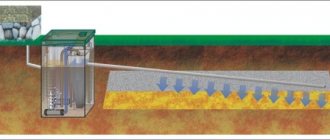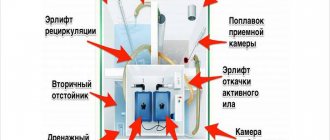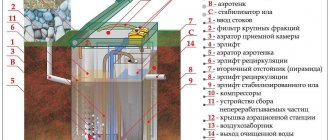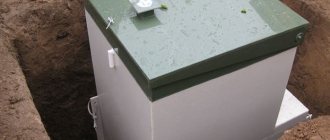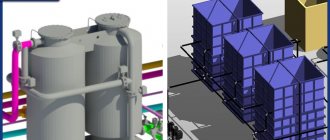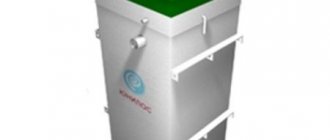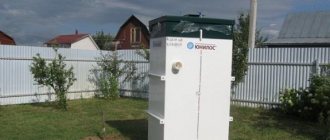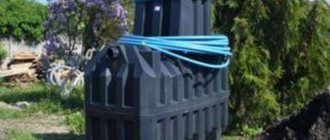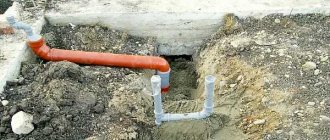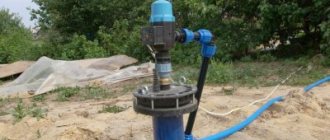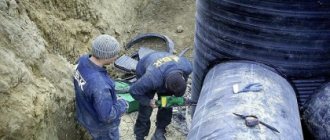When laying a sewer collector from a house to a septic tank or storage tank, you should adhere to the basic rules regulated by SNiP 2.04.03–85 regarding the level of the pipeline. Therefore, those who do not know how deep to bury a sewer pipe will learn a lot of useful information from our material.
Important: SNiP 2.04.03–85 regulation is not strictly mandatory, since it contains a very streamlined footnote that allows you to vary the level of the collector installation depending on the soil characteristics and climatic conditions of a particular region. And as an example, take the existing working sewer networks in the region.
SNiP offers only averaged data for laying the collector from the house to the septic tank in maximum and minimum reflection.
Principles of sewer pipeline construction
Principles of sewer pipeline construction
If you decide to install a septic tank and a pipeline to it from the house, then SNiP provides the basic rules for creating a high-quality and efficient wastewater disposal system.
- Thus, it is recommended to install the collector solely based on the previously drawn up design documentation. At the same time, when creating a project, it is very important to take into account all the communications available on the site, such as water supply, electricity, etc., located in the ground.
- It is necessary to draw up a sewerage project for the site taking into account a possible increase in the load on the collector in the future.
Important: according to SNiP, the ideal sewerage project is considered to be one that requires a minimum investment and at the same time allows you to create an effective working system.
Types of pipes
Local sewerage involves the installation of pipes not only for supplying wastewater to septic tanks, but also for overflowing it between containers, as well as for discharging purified water to the filtration field. As a rule, they are made of plastic:
- polyethylene;
- polyvinyl chloride;
- propylene.
In addition, pipes will be needed for ventilation and maintenance of the septic tank . They are installed vertically directly on the tanks. For ventilation, you will need to purchase PVC pipes, the diameter of which must be at least 110 mm.
Consultation with a specialist will help you make the right choice. But in any case, you will need to decide on:
- volume of the septic tank;
- length of pipelines;
- manufacturer of the product.
Factors affecting the level of pipeline laying
Specialists who will be involved in a project to develop a sewer collector in a private house must take into account several factors that will affect the depth of pipes. These are:
- Climatic conditions of a certain region. That is, here it is the area of soil freezing that is taken into account. Moreover, if the region in which the pipeline will be laid is prone to severe frosts in winter, then it is better to increase the laying level from that recommended in SNiP by 30% on average.
- Method of laying the pipeline (with or without trays).
- Soil composition (swampy, sandy, prone to shifting or heaving, etc.).
- Type of sewer system (gravity/free-flow or pumped).
What factors to consider when choosing the depth of a septic tank
Everyone tries to solve the issue of autonomous sewerage in a country house in different ways. Some make them with their own hands from concrete rings, car tires, bricks and other materials, while others buy ready-made products from plastic and metal. In any case, it is important to know at what depth to bury the septic tank. This depends on various factors:
- Ground water level. This is especially important, given that sometimes water that is not purified in the best way gets into the soil, so the waste disposal unit must be located above the ground water level, and in the average version it is 1.5 meters.
- The composition of the soil, and some types of cleaning, for example, are not suitable for clay soils, but are recommended for installation in sandy soil and sandy loam.
- The depth of soil freezing, and this is especially true when we are talking about the northern regions of Russia. If sewer pipes can be insulated, and they are often mounted even on the surface, then insulating a septic tank is much more difficult. Therefore, many people try to bury the unit so that the contents do not freeze, which often leads to the destruction of the structure.
In addition to the listed factors, the terrain often plays an important role. If the site has significant differences in height, depressions and slopes, it is not difficult to ensure independent movement of wastewater. Otherwise, you will have to use a fecal pump, although there is another way out of the situation - dig a septic tank to a greater depth, so that the sewer pipes have a slope towards the device. By the way, the performance of the VOC also largely depends on the location of the pipeline, and therefore it is important to know the depth of the sewer pipe to the septic tank.
How can you reduce the depth of the reservoir?
You can also use several ways to reduce the parameters of trenches in a private area from the house to the septic tank, if it is not possible to dig them deeper. The main ones are:
- Using a powerful fecal drainage pump, which will increase the flow rate of wastewater, thereby preventing stagnation and freezing of feces in the system.
- Use of pipes with high strength characteristics and wall thickness. These can be cast iron or steel pipes for the sewer system.
- Artificial increase in soil thickness over a laid sewer in a private house. To do this, you can use landscape design tricks in the form of a beautiful hill with flowers, etc.
Why choose Septic Topas Plus products
Many companies offer the sale of equipment and installation of local sewage systems, and the company Septic Topas Plus is successfully engaged in this in the Moscow and Moscow region markets. We offer our clients exclusively high-quality waste disposal units - the best-selling and best models Topas, Unilos Astra, Eurolos, Termit, Tver, Diamant, Ergobox, Dochista, Terra, Biozon and Kolovesi. Each septic tank comes with a 3-year warranty, all devices are certified, and their price fully corresponds to the quality. A flexible system of discounts has been developed for regular customers, and there is an affiliate program.
Source
Maximum depth for the reservoir
If a decision is made to lay the pipeline below the freezing level of the soil, then it is worth taking into account that the pressure of the earth on the pipes can play a cruel joke. That is, over time the pipe may simply burst. As a result, nature will suffer environmental damage, and the owner of the private home system will suffer financial damage. After all, repairs to the pipeline inside and outside the house will have to be carried out.
And yet, in some cases there is a need for deep laying of the system. In this case, SNiP regulates that for land with a high level of groundwater and for soil with rock inclusions, the collector can be lowered to a level of up to 3-4 meters. If the soil is dry and not heaving, then the maximum distance of the collector from the surface of the earth can be 5-8 meters.
Important: if there is a need to increase the maximum recommended laying level of the pipeline, then the collector must be placed in reinforced concrete trays to prevent soil pressure on the drainage system. In addition, in this case it is better to use durable rigid pipes made of two-layer corrugated PET.
Example calculation of a septic tank for a family of 4 people
For example, you can consider the option of calculating a septic tank for servicing a house where 4 people permanently live.
This can be easily calculated using the formula: 3 x Q, where Q is the water consumption per day. The amount of time a septic tank needs to process wastewater can be calculated as follows:
0.8 x tx (100% - 30% / 100%) x 120% = 0.8 x t x 0.7 x 1.2 = t x 0.672 sec.
0.8 – consumption of solid residue of processed wastewater, calculated per person; t – decay time of solid residues in days; 100% – total volume of sludge; 30% – percentage of natural decomposition of sludge; 120% – 100% total volume of sludge + 20% sludge residues after the previous cleaning of the septic tank.
To take a closer look at calculating water consumption per person per day, you should first determine the amount of use of plumbing equipment, as well as the frequency of use of plumbing equipment in the house.
Photo: amount of use of plumbing equipment
For calculations per person, let’s take a minimum water consumption of 150 l/day.
So, for example, the average consumption and consumption of water by one person can make up the following picture:
- one minute of taking a shower will consume about 10 liters of water;
- taking a shower or bath takes about 7-15 minutes on average;
- when using a bidet or toilet, water consumption is about 8 liters;
- Using a bidet takes an average of 5 minutes;
- One bath or jacuzzi requires 110 liters of water;
- a washing machine with a load of 2 kg of laundry consumes 70 liters of water per wash;
- A dishwasher spends 15 liters of water during one cycle of operation.
Let's try to calculate the water consumption per person, at least based on their use of a shower, bidet and bath:
(150 + 10 x 7 + 8 x 5 + 110) = 370 l/day.
Thus, from the minimum daily water consumption by one person, we reached the maximum daily water consumption by one person – 370 l/day.
Both indicators, minimum and maximum, are indicated in SNiP 2.04.09-85, which indicates the correctness of the calculations.
Now let’s calculate the total consumption (Q) for water consumption, including the washing machine and dishwasher, for 4 people permanently residing in the house:
Q = 370 x 4 + 70 + 15 = 1565 = 1.6 cubic meters per day
Considering the previous formula for calculating the volume of a septic tank - 3 x Q, we can now calculate the volume of a septic tank to serve a family of 4 people:
3 x 1.6 = 4.8 m3
4.8 m3 in this situation is the most optimal indicator for calculating the volume and size of the septic tank. If you need to take into account the minimum size of the septic tank, then you can use the following calculations:
4.8 x (1-0.2) = 3.84 m3
This must be done in cases where it is necessary to reduce the size of the septic tank to its minimum use when there are 4 permanent residents.
The formula for calculating the reduction uses only the permissible rate of wastewater treatment that is less than 20%; it cannot be reduced more.
If this assumption is violated, emergency flooding of the septic tank may occur, poisoning of the soil and the environment and, as a result, the imposition of high fines by government agencies. Who will have every right to do so.
To calculate the required depth for the construction of a particular septic tank, which will have to serve a family of 4 people, you can use the following standard calculations:
4.8 / 1 / 1.8 – 2.6 meters, where
4.8 – cubic meters of septic tank volume; 1 – meter of septic tank width; 1.8 – meters of septic tank length.
Such a measure may be necessary if your garden plot is limited in area and you cannot give a lot of land for the development of a septic tank.
In some regions of Russia, the depth of soil freezing is about 2 meters or more.
Any violation or deviation from the norms and rules adopted in the state documentation of SNiP leads, as a rule, to a complete stop in the operation of a particular septic tank, as well as to the imposition and payment of fines in large amounts, provided for by the legislation of the Russian Federation.
Important! Therefore, before constructing or installing finished treatment equipment, it is necessary to clearly monitor all the rules and regulations for the installation of autonomous sewers, which can be found, first of all, in SNiP 2.04.03-85 “Sewerage. External networks and structures" and other regulatory documents
It is also necessary to make a number of correct and accurate calculations regarding the volume of water consumption, the volume of the septic tank, its design and installation parameters
External networks and structures" and other regulatory documents. It is also necessary to make a number of correct and accurate calculations regarding the volume of water consumption, the volume of the septic tank, its design and installation parameters.
Method for calculating the depth of a pipe connected to a storage tank
The size of the pipe outlet in the room increases by the length of the external line, multiplied by a coefficient, the value of which is selected according to the diameter of the pipe:
- D 50 mm – 0.03;
- D 110 mm – 0.02;
- D 160 mm – 0.008;
- D 200 mm – 0.007;
The calculation is carried out according to the formula:
h2=h1+l*k+g,
h2 – depth of the point from where the exit and connection to the storage tank is made;
h1 – the value of the exit from the room. Take 1.4 m;
l – distance from the foundation to the storage well. Usually 10 meters.
k is the slope coefficient of the sewer pipe, always equal to 0.02;
g – natural slope of the surface. Usually does not exceed 0.3 m.
h2=1.4+10*0.02+0.3=1.9 m.
According to the calculation data, a sewer trench is created.
Why is ventilation needed?
An important element of a septic system, without which it cannot fully function, is ventilation. The answer to the question of whether ventilation is needed in a septic tank is most often positive. Let's take a closer look at why you need to ventilate a septic system:
- in the second tank (compartment) there are aerobic bacteria that process wastewater after the first tank. These bacteria are necessary for the most effective purification of water from solid inclusions. The vital activity of microorganisms is associated with sufficient access to oxygen. Which is ensured by the flow of air from a ventilation pipe installed inside the tank lid;
- a product of the vital activity of aerobic and anaerobic bacteria - a mixture of gases that, at a certain concentration and accompanying conditions, pose a certain danger to human life. Among them: hydrogen sulfide, methane, carbon dioxide, volatile arsenic salts, phosphorus compounds, etc. Some of them are explosive or cause serious harm directly to human health. Their discharge must be ensured using the supply and vent pipes;
- When flushing waste water through the toilet, a vacuum occurs, creating a vacuum space. If there is no vent riser, the water seal of the toilet may be torn off, then the gas mixture from the septic tank will rise into the house. It sometimes gets inside the premises when flushing water, this is immediately determined by the unpleasant odor.
When a septic structure is equipped with ventilation, the gas flow moves up the drainpipes, and then rises through the drain riser and exits the system to the outside.
How to properly locate a treatment facility on a site
All local treatment facilities must be installed in accordance with SNiP standards, which strictly determine their distance to sources of drinking water, trees, house, outbuildings, neighbor’s fence and road. Modern deep cleaning stations are much safer than anaerobic septic tanks, but do not forget that in an emergency, the possibility of environmental pollution remains, so you must adhere to all established rules, which must fully comply with regulatory documentation. This will not only preserve the ecological balance, but will also avoid claims from the SES and neighbors.
Very often, owners of septic tanks have a question about how to properly install a septic tank on a site, in a country house, and also what rules exist for a cottage.
Here are the basic rules that apply to all real estate:
- the distance to the neighbor’s fence should be at least 2 m, and if trees and shrubs grow immediately behind it, then 4 m. The same applies to your own garden;
- the distance to the water intake point should be 50 m on sandy and gravel soils, and 25-30 m on clay and loamy soils;
- distance to the house and outbuildings - 5 m or more;
- distance to reservoirs is about 10 m;
- the distance to the road is no closer than 5 m.
If the septic tank needs periodic pumping using sewage disposal equipment, then unobstructed access should be provided for it. To avoid claims from neighbors, you need to agree in advance on the installation of your septic tank in relation to their site. This will help avoid conflicts and misunderstandings in the future.
Common problems and their solutions
The most common problem is blockage. Frozen fat in pipes, unfortunately, is practically not dissolved by acids and alkalis - neither liquid “Mole” nor nitric acid will help when clogged with fats. If the cause of the blockage in a large pipe is not clear, and the liquid passes slowly, you can pour out the alkali (“Mole”) and then slowly rinse the system with hot water. If the blockage is due to organic residues, then there is a chance to at least partially clear the pipe and survive until the plumbers arrive. Acid acts much more slowly on organic matter.
When using any chemicals, you must remember the fact that alkalis and acids destroy bacteria in a septic tank or treatment plant and slow down the process of processing sewage.
The advice to pour a couple of buckets of boiling water down the drain can damage siphons and the top of plastic communications and cracks in a faience sink or toilet.
Another problem is the smell. It is necessary to find leaks and seal the communications, and also check that the water plug in the siphon has not dried out (or spilled out through damage). In this case, replace or seal the siphon and add water.
The most serious problem is the destruction of communications due to freezing or damage from heavy equipment or ground shifts. In this situation, you cannot do without digging a trench and replacing the damaged part. To protect against soil shifts, when installing communications, it is necessary to backfill with sand (non-compactable soil) - a layer of 5 cm under the pipe and 10 cm on top of the pipe.
Pipe insulation
If necessary, the pipeline is insulated with material that does not absorb moisture - foil-coated polyethylene foam, polyurethane foam shells. Mineral wool is not suitable for this purpose.
Ventilation
In general, sewer risers must be ventilated. Pipes must be installed above the roof level by at least 500 mm. There are two reasons:
- The entry of air into the system and the removal of aggressive gases reduces corrosion of the metal parts of the system (not relevant for plastic) and protects the premises from the occurrence of unpleasant odors.
- Air access prevents the water seals of the siphons located above from breaking when flushing the toilet.
This issue is very relevant for an apartment building, but in a private building it is not so problematic.
In a private house, the drain riser above the toilet connection level can be narrowed - a pipe of a smaller diameter can be installed. You can abandon the fan pipe and install a special valve that allows air to enter the system. If there is only one toilet connected to the riser, you can refuse ventilation altogether - the volume of a modern tank is small, it leaks through the toilet for almost 10 seconds and therefore does not completely cover the cross-section of the riser and the danger of the water seals breaking is minimal. If there are two toilets and a lot of people live, it is better to install a valve.
Ventilation of a septic tank, cesspool or autonomous treatment plant is a prerequisite for ensuring reliable operation of the structure.
More
You need to know that plastic pipes do not become overgrown with salts, but fats (and suspended particles) can settle on their walls. There are no ways to combat this scourge - the pipes will have to be cleaned every few years. The situation is slightly improved by using liquid rather than abrasive detergents and using a dishwasher.
